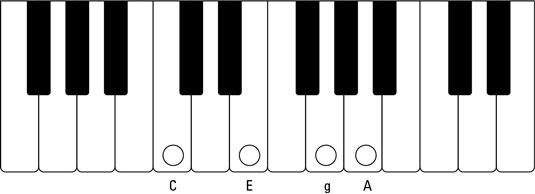In tuning instructions — and in the real world — you encounter a couple of key terms:
-
Open string: A string you play without holding the string down.
-
Fretted string: A string you play while holding the string down at a certain fret.
You can also use a digital device to tune your ukulele.
Tuning your ukulele to a guitar
If you’re playing with a guitarist, you want to make sure that you’re in tune with each other. Otherwise you end up sounding like a back-alley banjo fight.After the guitarist is in tune, ask him or her to play these notes and match your strings as indicated:
| Ukulele | Guitar |
|---|---|
| g-string | E-string third fret |
| C-string | B-string first fret |
| E-string | E-string open |
| A-string | E-string fifth fret |
Tuning your ukulele to a piano or keyboard
Pianos hold their tuning much longer than most string instruments. Electronic keyboards are even better because their notes are produced digitally and are always spot-on. So if you have a piano or keyboard handy, you have the perfect tuning source.The C-string of a ukulele (the fattest one) equates to the middle C on a piano. Two white keys up from the C is E. Up two more white keys to G and up to the next white key for A.

Tuning your uke to itself
If you’re stuck with nothing to help you tune, you can always tune the ukulele with itself. This method is pretty tricky, however, so if you have another option, use it. Practicing this method of tuning can come in useful, however, because you never know when you’re going to get caught without a tuner or other instrument.You can start with the C-string (the third one up) because it tends to hold its tuning best:
-
Play the C-string at the fourth fret and pluck it.
-
Now play the open E-string (the third one) and compare the sounds.
When you’re in tune, these notes sound the same. Adjust the tuner on the E-string until they sound the same.
-
Play the E-string at the third fret and then the open g-string (the first one).
Adjust that g-string until it’s in tune.
-
Play the E-string at the fifth fret and tune the A-string (the fourth one) to that note.

